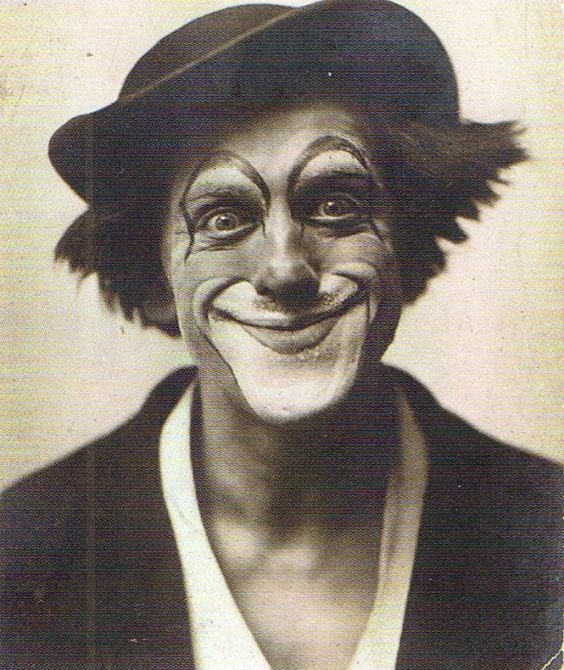
grock:Project
«Io sono il risultato di mezzo secolo di osservazione e di ostinazione, del desiderio di perfezionare ciò che era già perfetto. Sono convinto di esserci riuscito.»
Subject of the project, intentions and goals.
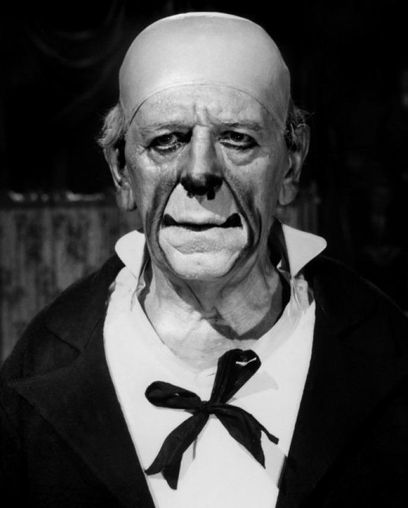
Our idea revolves around two main premises:
Explanation of our idea through an Entity-Relationship model.
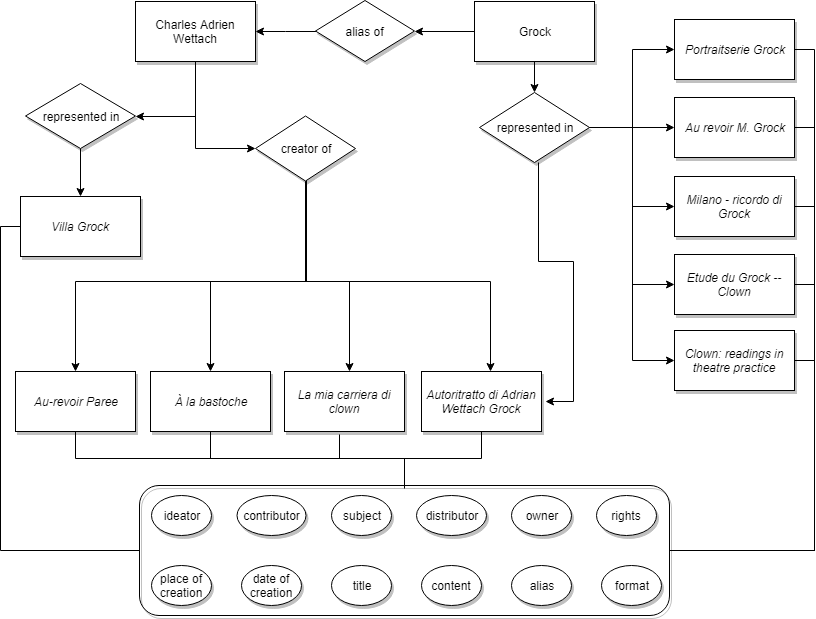
The items we selected and their respective metadata analyses.
Mapping of metadata elements highlighted during the analysis phase.
We defined the alignment between the different used standards for metadata (related to people, place, date and concepts) by asking ourselves a series of questions related to such categories and by selecting the metadata elements we deemed to be more relevant for our model.
The questions we asked ourselves during the process of metadata mapping focused on the roles of people involved with the creation, distribution and conservation of the item. Regarding date and place, we chose not to delve too deep since it is information that our model will focus on only marginally. With regards to concepts, we chose to focus on general ideas related to some object properties, such as the title and the format.
| Question |
|---|
| Who is the creator of the item? |
| Who contributed to the item's creation? |
| Who is the distributor of the item? |
| Who is the subject of the item? |
| Who is physically owning the item? |
| Who owns the intellectual property rights of the item? |
| When was the item created? |
| Where was the item created? |
| What is the title of the item? |
| What is the content of the item? |
| What is the format of the item? |
| What is the alias of the person? |
Creation of a theoretical framework, modeled by exploiting FRBR conceptual structure.
We decided to base our theoretical model on the FRBR structure. What we did, for each object, was to conceptually treat it from the point of view of all the FRBR Group 1 entities at once and to insert each metadatum we deemed to be relevant to our task into its respective entity slot (either work, manifestation, expression or item). In this way, we were allowed to give a distinct and clear answer to each question we developed during the alignment phase.
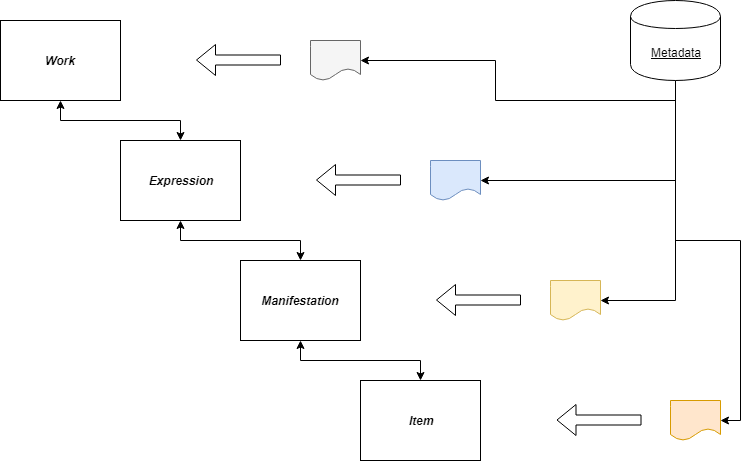
We then applied this theoretical model to three of our objects:
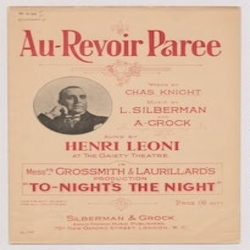

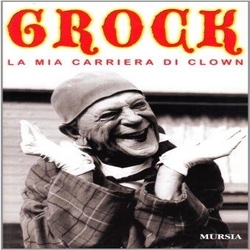
Creation of a conceptual model by reusing other existing models.
Starting from the E/R model, the metadata alignment and the theoretical model, the next step was to create an actual conceptual model able to adequately describe the data at our disposal.
With regard to the date format, we chose to use either the DMY format (in case we are dealing with a precisely defined date) or xsd:gYear (in case we are dealing with a vaguely defined date, without a precise day and/or month of that year).
| DD/MM/YYYY | W3 Consortium |
| xsd:gYear | RELAX NG |
| Question | Property | Schema |
|---|---|---|
| What is the person's name? | person:birthName | Core Person Vocabulary |
| What is the person's alias? (optional) | poder:alias | Poder Vocabulary |
| Where was the person born? | person:placeOfBirth | Core Person Vocabulary |
| When was the person born? | core:dateOfBirth | Core Concept Ontology |
| Where did the person die? (optional) | person:placeOfDeath | Core Person Vocabulary |
| When did the person die? (optional) | core:dateOfDeath | Core Concept Ontology |
| What is the person's job/occupation? | gvp:aat2312_perform | Getty Vocabulary Program ontology |
| What is an item related to the person? (optional) | gvp:aat2000_related_to | Getty Vocabulary Program ontology |
| Who does the person know? (optional) | foaf:knows | Friend Of A Friend |
With regards to people, we decided to use the Core Person Vocabulary to describe the identity of an individual, enhanced with properties from Friend Of A Friend, Poder Vocabulary, Getty Vocabulary Program ontology and Core Concepts Ontology. As for the last two properties aat2000_related_to and foaf:knows, we are aware of the vagueness of them (especially that of the former, since it is not specified whether the person is the item's creator, producer, distributor, etc...), but we were mostly interested in expressing some kind of relation with at least a person and, possibly, a cultural object of some sort. An interesting future development of this model could consist in implementing a more detailed system of relationships at this level, from the point of view of both objects and people related to the person.
With regards to places, we decided to keep the description to a minimum that would still be useful to us. We used the Location Core Vocabulary to describe a specific place in terms of its name, and the GeoNames ontology to add information about the country in which that place is located.
| Question | Property | Schema |
|---|---|---|
| What is the name of the place? | locn:geographicName | Location Core Vocabulary |
| What is the country in which the place is located? | gn:countryCode | GeoNames |
| Question | Property | Schema |
|---|---|---|
| What is the occupation? | rdfs:label | RDFS |
| How could it be described by exploiting an uncontrolled description? | rdfs:comment | RDFS |
| How could it be described by exploiting a controlled vocabulary? | dcterms:subject | Dublin Core |
| Who performs this occupation? | gvp:aat2311_performed_by | Getty Vocabulary Program ontology |
With regards to concepts, we decided to focus on people's occupations, which we managed to describe by using a mixture of general properties of RDF Schema and Dublin Core and the Getty Vocabulary Program ontology's "aat2311_performed_by" property (inversely related to "aat2312_perform"). Another interesting development could consist in implementing a more sophisticated and complex model in order to be able to describe concepts, other than occupation, related to people and their doing.
Natural language tabulated description of some toy data we chose for each category (People, Places, Concepts).
| Subject | Property | Object |
|---|---|
| [Charles Adrien Wettach] | |
| person:birthName | "Charles Adrien Wettach" |
| poder:alias | "Grock" |
| person:placeOfBirth | [Lovelesse] |
| core:dateOfBirth | 10/01/1880 |
| person:placeOfDeath | [Imperia] |
| core:dateOfDeath | 14/07/1959 |
| gvp:aat2312_perform | [Clown] |
| gvp:aat2312_perform | [Illustrator] |
| gvp:aat2312_perform | [Actor] |
| gvp:aat2312_perform | [Musician] |
| aat2000_related_to | [Autoritratto] |
| foaf:knows | [Suzy Prim] |
| Subject | Property | Object |
|---|---|
| [Suzanne Mariette Arduini] | |
| person:birthName | "Suzanne Mariette Arduini" |
| poder:alias | "Suzy Prim" |
| person:placeOfBirth | [Paris] |
| core:dateOfBirth | 11/10/1896 |
| person:placeOfDeath | [Boulogne-Billancourt] |
| core:dateOfDeath | 07/07/1991 |
| gvp:aat2312_perform | [Actor] |
| gvp:aat2312_perform | [Producer] |
| aat2000_related_to | [Au-revoir M. Grock] |
| foaf:knows | [Charles Adrien Wettach] |
| Subject | Property | Object |
|---|---|
| [Jon Davison] | |
| person:birthName | "Jon Davison" |
| person:placeOfBirth | [Bexley] |
| core:dateOfBirth | 1962 |
| gvp:aat2312_perform | [Teacher] |
| gvp:aat2312_perform | [Writer] |
| gvp:aat2312_perform | [Clown] |
| gvp:aat2312_perform | [Musician] |
| aat2000_related_to | [Clown: readings in theatre practice] |
| Subject | Property | Object |
|---|---|
| [Florence] | |
| locn:geographicName | "Firenze"@it |
| gn:countryCode | "IT" |
| Subject | Property | Object |
|---|---|
| [Paris] | |
| locn:geographicName | "Paris"@fr |
| gn:countryCode | "FR" |
| Subject | Property | Object |
|---|---|
| [Basingstoke] | |
| locn:geographicName | "Basingstoke"@en |
| gn:countryCode | "GB" |
| Subject | Property | Object |
|---|---|
| [Actor] | |
| rdfs:label | "Actor"@en |
| rdfs:comment | "An actor (or actress for female) is one who portrays a character in a performance. The actor performs "in the flesh" in the traditional medium of the theatre, and/or in modern mediums such as film, radio, and television. The analogous Greek term is ὑποκριτής (hupokritḗs), literally "one who answers". The actor's interpretation of their role pertains to the role played, whether based on a real person or fictional character. Interpretation occurs even when the actor is "playing themselves", as in some forms of experimental performance art, or, more commonly; to act, is to create, a character in performance."@en |
| dcterms:subject | [Entertainment_occupations] |
| gvp:aat2311_performed_by | [Charles Adrien Wettach] |
| gvp:aat2311_performed_by | [Suzanne Mariette Arduini] |
| Subject | Property | Object |
|---|---|
| [Illustrator] | |
| rdfs:label | "Illustrator"@en |
| rdfs:comment | "An illustrator is an artist who specializes in enhancing writing or elucidating concepts by providing a visual representation that corresponds to the content of the associated text or idea. The illustration may be intended to clarify complicated concepts or objects that are difficult to describe textually, which is the reason illustrations are often found in children's books."@en |
| dcterms:subject | [Arts_occupations] |
| dcterms:subject | [Aesthetics] |
| gvp:aat2311_performed_by | [Charles Adrien Wettach] |
| Subject | Property | Object |
|---|---|
| [Clown] | |
| rdfs:label | "Clown"@en |
| rdfs:comment | "Clowns are comic performers who employ slapstick or similar types of physical comedy, often in a mime style."@en |
| dcterms:subject | [Comedy] |
| dcterms:subject | [Performing_arts] |
| gvp:aat2311_performed_by | [Charles Adrien Wettach] |
URI design and RDF description, enriched with semantic connections, for three instances we chose (one for each category).
| Item | Person | Place | Concept |
|---|---|---|---|
| Au-revoir M. Grock | Suzanne Mariette Arduini | Paris | Actor |
| Autoritratto | Charles Adrien Wettach | Florence | Illustrator |
| Clown: readings in theatre practice | Jon Davison | Basingstoke | Clown |
We created three URIs for three instances (Suzanne Mariette Arduini for People, Florence for Places and Clown for Concepts) and described them by using the RDF Turtle serialization.
Table 16 shows the semantic relations we added to our RDF description in order to describe some connections our data could have with other resources that are effectively implemented on the Web in Linked Open Data. We used very simple yet meaningful relations (such as similarity, difference, hyponymy, meronymy, hyperonymy).
| Relation | Property | Schema |
|---|---|---|
| Similarity | owl:sameAs | OWL |
| Difference | owl:differentFrom | OWL |
| Hyponymy | wn:hyponymOf | WordNet |
| Meronymy | wn:meronymOf | WordNet |
| Hyperonymy | wn:hyperonymOf | WordNet |